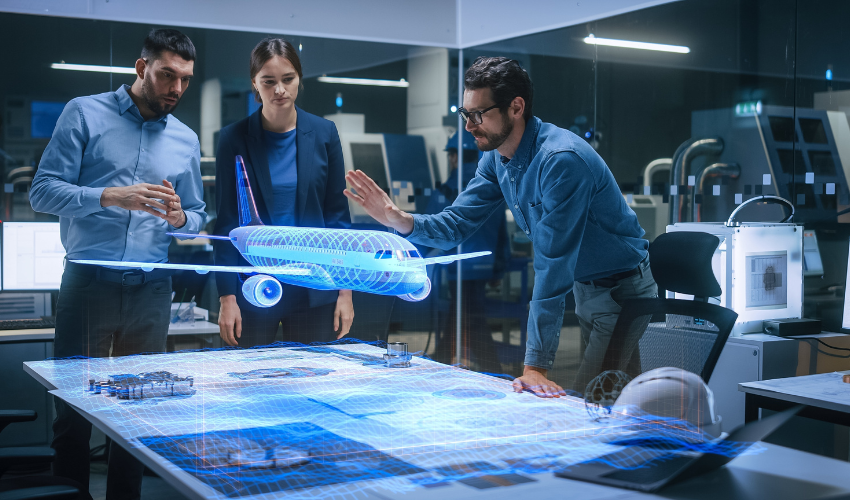
Artificial Intelligence has come a tremendously long way throughout the decades and the way we live our everyday lives is proof of it. From what seemed like an interesting futuristic concept in early Sci-Fi movies has now come into our reality. More people are starting to become aware of how phenomenal and advanced AI technology is and what it can become. AI is changing the way we perform the simplest of tasks and it’s only growing more advanced as time goes on. And AI isn’t just smart devices, digital voice assistants, or complicated algorithms—it’s so much more.
AI can help us with personal tasks, but what about everything beyond that? There are many industries that are working together with AI to improve their processes and increase safety; industries such as aerospace.
The aerospace industry has always been at the forefront of technological advancements, and the integration of AI is no exception. From the smallest electronic components to the most complex systems, AI technologies are reshaping aerospace electronics, influencing design, manufacturing, operations, and safety.
The landscape of inspecting and controlling the quality of electronic components has undergone a significant transformation, all thanks to the power of AI. The integrity of each electronic part holds immense importance, as even the tiniest flaw could potentially throw off the aerospace operation. This is where AI comes in.
Sophisticated machines equipped with advanced vision algorithms meticulously examine each and every component, scrutinizing them in ways that human eyes might overlook. This rigorous inspection process ensures that aerospace electronics are manufactured with an unparalleled level of precision and reliability.
Whether we’re talking about circuit boards or sensors, these components stand as the guardians of the end product’s integrity.
Embedded within aerospace electronics, sensors play a pivotal role in predictive maintenance. These small components work around the clock, keeping tabs on the well-being and performance of electronic components. Data is sent to AI systems, which work to predict potential problems down the line. This approach helps swap out components before they malfunction which amps up safety levels and makes sure everything runs smoothly without any unexpected bumps.
Electronic components power the sensors and processing units responsible for detecting and neutralizing threats. These components work hand in hand with AI algorithms, swiftly processing data to spot potential dangers, like impending collisions or adverse weather patterns. This rapid analysis and response mechanism is a critical layer of defense, ensuring the safety of passengers and crew.
Behind the scenes, electronic components work together to amplify the capabilities of AI algorithms that act as co-pilots for the aviation crew. This collaboration sets the stage for pilots to receive unparalleled decision support. Components play a pivotal role by carefully processing an extensive stream of data originating from sensors, avionics systems, and external inputs.
This real-time analysis provides pilots with on-the-spot insights that elevate their understanding of the surrounding environment. This causes pilots to gain insights that elevate their situational awareness, enabling them to make well-informed judgments and ensuring heightened safety even in the face of challenging conditions.
And we cannot forget how important air traffic management is. AI algorithms dive deep into data pulled from radar systems, communication networks, and electronic sensors. This information fuels a seamless optimization of flight paths, cutting down on congestion and giving a boost to airspace efficiency.
Electronic components, spanning from microcontrollers to memory units, step up to the plate as facilitators for AI simulations. These simulations do more than just alter designs – they empower engineers to refine individual component specifications while also optimizing their integration into intricate systems. The components are being prepped to handle the demanding aerospace environment. And what’s the result? Top-notch performance and components that stand the test of time.
These components basically shape what autonomous systems can do up in the aerospace industry. Take microcontrollers, for example, the “brain” that processes data. And then there are sensors, which immediately collect data. Together, they’re like the eyes, ears, and brains of autonomous aircraft, and AI makes sure these components work in perfect harmony, navigating, making decisions, and adapting almost instantly.
Within the aerospace industry, Area51 Electronics plays a vital role as a distributor of cutting-edge, authentic electronic components. Our comprehensive product range speaks volumes about our commitment to providing tailored solutions for the diverse needs of the aerospace industry.
From the critical functionality of telemetry and the comfort-enhancing in-cabin elements to the robustness of ground support systems and the captivating features of infotainment solutions, we cover the entire spectrum. Even the small yet crucial aspects, like connectors & fasteners, that hold everything together.
By supplying these essential building blocks of technological transformation, Area51 Electronics fuels the revolution that is reshaping the aerospace industry.
https://area51esg.com/solutions/industries/aerospace-defense/